myths of winter
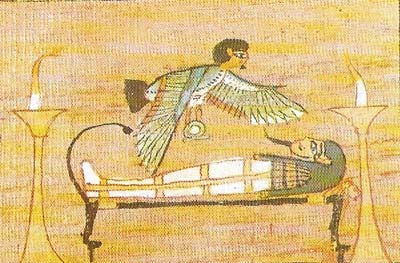
Figure 1. After death, the Egyptians believed, life continued in the underworld. Each person had a double, or Ka, representing the divine essence. Here it is shown as a strange creature with human head and falcon's body. Although Ka is as spiritual as any Christian soul, a concrete explanation was needed for its ability to fly across the underworld with the corpse to which it belonged.
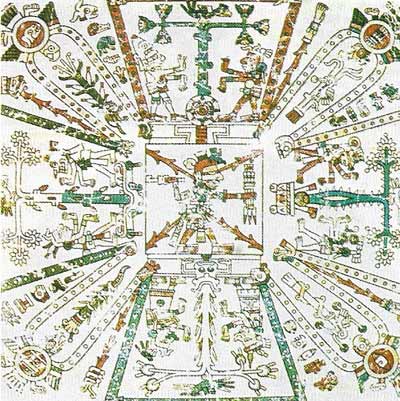
Figure 2. One Aztec myth depicted four destroyed worlds with the present one in the center and suggested that the human race had been wiped out in earlier times because it had been too self-opinionated. If men became too proud, the present world would itself be destroyed by means of an earthquake. The ending of a universe and the beginning of a new era was predicted in many other traditions. Greco-Roman mythology spoke of a descending order of world eras from a "golden" to an "iron" age, the baser metal indicating a progressive worsening of the human condition.
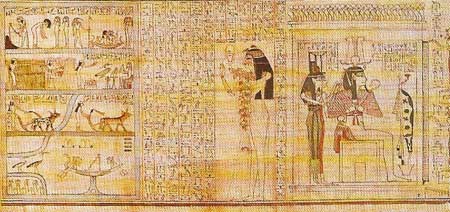
Figure 3. The other world, according to the Egyptian Book of the Dead, was a realm in which the blessed dead lived much as they had always done, only in a state of more perfect happiness, farming the Elysian fields. Osiris, the supreme ruler and judge of the dead, is here attended by his wife-sisters, Isis and Nephthys. His insignia are agricultural. There were no spiritual occupations or heavenly choirs as in Semitic religions.
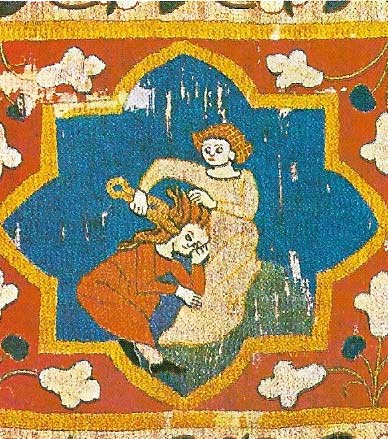
Figure 4. Implications of sacrifice underlie the Hebrew story of how Samson's hair was treacherously shorn by Delilah. A connection between cutting the hair and losing physical strength is widespread and some Fijian chiefs ate a man as a precaution before cutting theirs. But the theme may also imply a transition from outer to inner strength, in keeping with the sacrifice of hair by nuns and orthodox Jewesses as a preparation for sacred marriage.
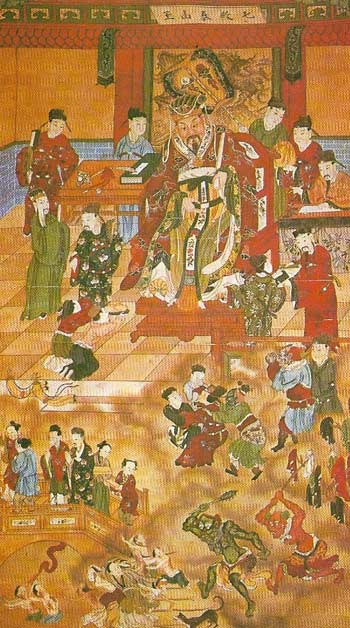
Figur 5. In Chinese mythology, hell was run like a well-ordered bureaucracy, reflecting the importance of administrative efficiency in China. Here, Yama, king of the Seventh Hell and supreme master of the law courts, dispenses a form of justice in which exact punishment is prescribed for each offence. Misers, for example, and dishonest mandarins have to swallow melted gold, while cannibals and desecrators of graves are chased by demons into a river. Investigation of souls takes place in the first of ten courts which assigns each soul to one of 18 hells designed to fit various crimes.
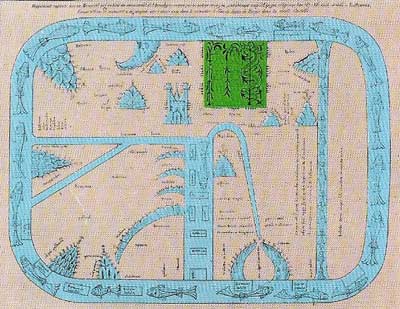
Figure 6. Myths are maps to guide and stimulate the imagination and orientate the individual in life. This 8th-century map by a Spanish priest, Beatus, divided the world into three continents inherited by the sons of Abraham. The surrounding ocean was not to be explored. Paradise was located in the east (top).
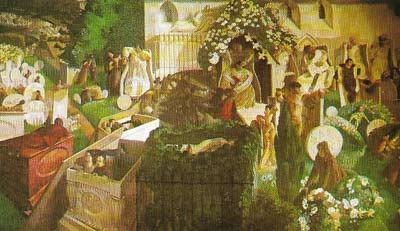
Figure 7. In "Resurrection" by the English painter Stanley Spencer (1891–1959), the Last Judgment has come for the good people of Cookham. Just like people coming up from a cellar, folk are climbing out of their graves, quite uncorrupted and freshly dressed for the occasion. The picture is a literal and earthly allegory of the sophisticated idea that souls can be reunited with their bodies in the building of a New Jerusalem. In many religions, emphasis on heaven or hell is waning, as is the importance of past or future lives. It is conceded that corresponding states of mind can exist here and now.
Death as ultimate finality is unacceptable to most human beings. Myth's function is, therefore, to explain that life in its known form must come to an end as inevitably as the arrival of winter but also to point to a future that is not accessible to our senses. It is in this void of unknowability that myths are most often employed.
 |
| In dead midwinter, nature rests under a blanket of snow, no sap rises and trees are being felled. But life lies underground in the seed corn and burns in the Promethean fires of man. |
Continuation or transformation?
Seeking to avoid the inevitable, man has created many myths about life-preserving remedies such as magic potions, elixirs of immortality or rejuvenation. In the Epic of Gilgamesh, for instance, the hero plunges into the cosmic sea with stones tied to his feet. At the bottom he finds the prickly herb of immortality, plucks it, cuts loose the stones and surfaces. But his triumph is short-lived, for while he is bathing in a fountain a serpent eats the herb. Shedding its skin periodically the snake becomes a symbol of rejuvenation and immortality while man has to come to terms with his mortality.
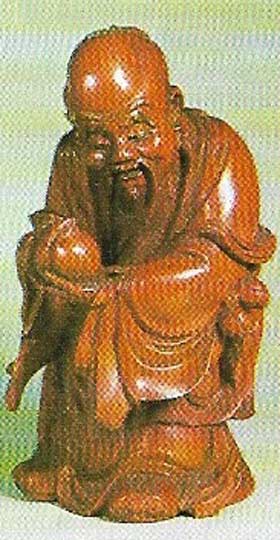 |
| Shou-Lao, symbol rather than god of longevity, holds a golden peach. These ripened only once in 3,000 years in a celestial garden, a Chinese parallel to the paradisaical Tree of Life elsewhere. |
Other semi-divine beings have tried to cheat death and its messengers. The Polynesian trickster Maui even tried to kill the goddess of death herself. With his friends the birds he crept up while she was asleep, intending to crawl into her body between her thighs, kill her, and escape through her mouth. At first he seemed to succeed but when a wagtail saw only his legs sticking out, it could not contain a chuckle which woke the goddess. She closed her thighs and her womb became his tomb.
A touching motif that reappears in myths of several regions is the attempt to rescue a loved one from the clutches of the underworld. That Izanami, who according to Japanese myth, had with her husband Izanagi, created the world out of the ocean, dies giving birth to fire. Izanagi, disconsolate at the loss, follows her into the Land of Darkness. He finds her in a castle and persuades her to return, but she delays because she has already eaten food there (as did Persephone in a similar Greek myth). Impatiently Izanagi uses a light and sees that she is already in an advanced state of decay. So angry is Izanami at being seen in a humiliating state that she tries to kill Izanagi. There is a chase and Izanagi barely manages to save himself.
A variation on this story is found in the Greek myth of Orpheus who, finding that Eurydice has died of a snake bite, decides to follow her to Hades. Such is the quality of his music that the torment of the damned stops and Eurydice is permitted to return with him on condition that he does not look back at her until they reach the upper world. His anxiety gets the better of him, however; he looks back and she is lost. (The fatal mistake of looking back is echoed in the biblical story of Lot's wife, who looked behind her on the way from Sodom and was turned into a pillar of salt.) The moral of these myths seems to be that man must learn to accept the inevitability of separations in life, of which death is the ultimate and most irrevocable.
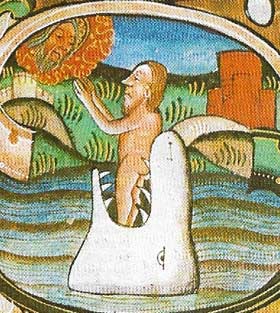 |
| The myth of Jonah and the whale represents a Hebrew variation of the theme of death and resurrection. On the surface it is the miraculous story of how the Lord sent a whale to Jonah when he had been cast out into the sea and of how he lived three nights and days in its belly before being delivered to dry land. At a deeper level it is an allegory of how Jonah atoned for disobeying God's command and was delivered from guilt. |
Beyond death: heaven and hell
Man's difficulty in accepting death as final is reflected in the universal theme of a world after death (Figures 1, 3 and 5]. In many traditions this is somewhere on the earth, often in the west (Eden (Figure 6) is an exception) and separated by water from the known world, such as the Celtic Avalon, the Greek Islands of the Blessed and the American Indian Happy Hunting Grounds. In some it is below the earth, such as the realms of Tumbuka (Malawi) and in yet others it is in the sky as are the Judeo-Christian heaven and the Buddhist and Hindu paradises.
Some realms admit all the dead regardless of their merits while others restrict entry to those who have earned it. The Greek Hades, for instance, accepts the souls of all who are ferried across the River Styx by Charon provided they have the necessary fare. But in the Judeo-Christian religions the soul is assigned to heaven or hell according to divine judgment of the person's life on earth, in the same way as the hearts of the dead are weighed by Anubis in Egyptian myths.
But merit is not always measured in moral terms and "heaven" often reflects in-equalities on earth. In the Leeward Islands only aristocrats are sent to "sweet-scented Rohutu" while commoners go to "foul-scented Rohutu". The mansions of the sun were open only to the Incas and nobles of Peru, while the Norse Valhalla was the prize of the mighty in war. Even the Christian heaven is not always gained by a pure life. Jean Calvin (1509–1564), the Swiss theologian, held that salvation was through arbitrary divine choice. Generally "heavens" are portrayed as beautiful parks or gardens filled with earthly delights, places of eternal youth and freedom from want.
The end of the world
A final mythological theme is that of the end of the world and a return to chaos. The gods imposed order on the world and they may well revoke their patronage. It is for this reason that festivals are celebrated, rituals performed and sacrifices made. But almost every mythology envisages a time of eventual destruction heralded by wars, famines, floods, hurricanes and earthquakes.
Traditions as separate as those of the Mexican Aztecs (Figure 2) and the Indian Hindus and Buddhists envisaged several world ages characterized by decreasing moral standards and piety. The Aztecs believed that when the last age had finished the world would be consumed with fire and everything destroyed.
